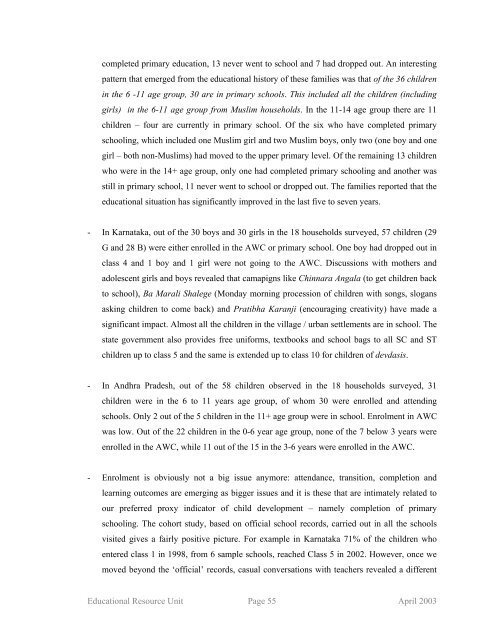Snakes and Ladders - ERU Consultants Pvt. Ltd.
Snakes and Ladders - ERU Consultants Pvt. Ltd.
Snakes and Ladders - ERU Consultants Pvt. Ltd.
You also want an ePaper? Increase the reach of your titles
YUMPU automatically turns print PDFs into web optimized ePapers that Google loves.
completed primary education, 13 never went to school <strong>and</strong> 7 had dropped out. An interesting<br />
pattern that emerged from the educational history of these families was that of the 36 children<br />
in the 6 -11 age group, 30 are in primary schools. This included all the children (including<br />
girls) in the 6-11 age group from Muslim households. In the 11-14 age group there are 11<br />
children – four are currently in primary school. Of the six who have completed primary<br />
schooling, which included one Muslim girl <strong>and</strong> two Muslim boys, only two (one boy <strong>and</strong> one<br />
girl – both non-Muslims) had moved to the upper primary level. Of the remaining 13 children<br />
who were in the 14+ age group, only one had completed primary schooling <strong>and</strong> another was<br />
still in primary school, 11 never went to school or dropped out. The families reported that the<br />
educational situation has significantly improved in the last five to seven years.<br />
- In Karnataka, out of the 30 boys <strong>and</strong> 30 girls in the 18 households surveyed, 57 children (29<br />
G <strong>and</strong> 28 B) were either enrolled in the AWC or primary school. One boy had dropped out in<br />
class 4 <strong>and</strong> 1 boy <strong>and</strong> 1 girl were not going to the AWC. Discussions with mothers <strong>and</strong><br />
adolescent girls <strong>and</strong> boys revealed that camapigns like Chinnara Angala (to get children back<br />
to school), Ba Marali Shalege (Monday morning procession of children with songs, slogans<br />
asking children to come back) <strong>and</strong> Pratibha Karanji (encouraging creativity) have made a<br />
significant impact. Almost all the children in the village / urban settlements are in school. The<br />
state government also provides free uniforms, textbooks <strong>and</strong> school bags to all SC <strong>and</strong> ST<br />
children up to class 5 <strong>and</strong> the same is extended up to class 10 for children of devdasis.<br />
- In Andhra Pradesh, out of the 58 children observed in the 18 households surveyed, 31<br />
children were in the 6 to 11 years age group, of whom 30 were enrolled <strong>and</strong> attending<br />
schools. Only 2 out of the 5 children in the 11+ age group were in school. Enrolment in AWC<br />
was low. Out of the 22 children in the 0-6 year age group, none of the 7 below 3 years were<br />
enrolled in the AWC, while 11 out of the 15 in the 3-6 years were enrolled in the AWC.<br />
- Enrolment is obviously not a big issue anymore: attendance, transition, completion <strong>and</strong><br />
learning outcomes are emerging as bigger issues <strong>and</strong> it is these that are intimately related to<br />
our preferred proxy indicator of child development – namely completion of primary<br />
schooling. The cohort study, based on official school records, carried out in all the schools<br />
visited gives a fairly positive picture. For example in Karnataka 71% of the children who<br />
entered class 1 in 1998, from 6 sample schools, reached Class 5 in 2002. However, once we<br />
moved beyond the ‘official’ records, casual conversations with teachers revealed a different<br />
Educational Resource Unit Page 55 April 2003












